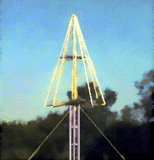
Back كشف عن البرق Arabic Stormscope German Detector de rayos Spanish Tximista-detektagailu Basque آذرخشیاب Persian Salamanpaikannin Finnish Détecteur de foudre French Fulminometro Italian 雷検知器 Japanese Fulminometro LMO

A lightning detector is a device that detects lightning produced by thunderstorms. There are three primary types of detectors: ground-based systems using multiple antennas, mobile systems using a direction and a sense antenna in the same location (often aboard an aircraft), and space-based systems. The first such device was invented in 1894 by Alexander Stepanovich Popov. It was also the first radio receiver in the world.
Ground-based and mobile detectors calculate the direction and severity of lightning from the current location using radio direction-finding techniques along with an analysis of the characteristic frequencies emitted by lightning. Ground-based systems can use triangulation from multiple locations to determine distance, while mobile systems can estimate distance using signal frequency and attenuation. Space-based detectors on satellites can be used to locate lightning range, bearing and intensity by direct observation.
Ground-based lightning detector networks are used by meteorological services like the National Weather Service in the United States, the Meteorological Service of Canada, the European Cooperation for Lightning Detection (EUCLID), the Institute for Ubiquitous Meteorology (Ubimet) and by other organizations like electrical utilities and forest fire prevention services.

- ^ "Instrument: Lightning Mapping Array (LMA) | Global Hydrometeorology Resource Center (GHRC)". ghrc.nsstc.nasa.gov. Retrieved 2022-08-29.